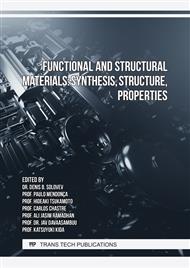[1]
A.S. Okhapkin, Study of the heat-transfer characteristics of a thermally protective composite materials, Journal of Engineering Physics and Thermophysics. Vol. 49, 6(1985) 1469-1473.
DOI: 10.1007/bf00871302
Google Scholar
[2]
O.M. Alifanov, V.V. Cherepanov, Identification of models and prediction of physical properties of highly porous heat-shielding materials, Journal of Engineering Physics and Thermophysics. Vol. 83 (2010) 770-782.
DOI: 10.1007/s10891-010-0396-1
Google Scholar
[3]
O.M. Alifanov, S.A. Budnik, A.V. Nenarokomov, A.V. Netelev, D.M. Titov, Destructive Materials Thermal properties determination with application for spacecraft structures testing. The 61th International Astronautical Congress (IAC-10) (Prague, Czech Republic) (2010) 10.
DOI: 10.1016/j.actaastro.2011.10.003
Google Scholar
[4]
J.A. Dec, R.D. Braun, B. Lamb, Ablative thermal response analysis using the finite element method, Journal of Thermophysics and Heat Transfer. Vol. 26, 2 (2012) 201–212.
DOI: 10.2514/1.t3694
Google Scholar
[5]
S.V. Reznik, P.V. Prosuntsov, K.V. Mikhailovskii, Prediction of Thermophysical and Thermomechanical Characteristics of Porous Carbon–Ceramic Composite Materials of the Heat Shield of Aerospace Craft, Journal of Engineering Physics and Thermophysics. Vol. 88, 3 (2015) 594–601.
DOI: 10.1007/s10891-015-1227-1
Google Scholar
[6]
M.V. Krashennikova, Trends and prospects of the development of compositions of distending fire protecting coatings for increase of limits of fire resistance of building constructions, Fire and explosion safety. Vol. 2(17) (2008) 36-39.
Google Scholar
[7]
N.A. Sipyagina, New composite materials on the basis of ceramic high porous heatprotective materials and aerogels, The VIII conference of young scientists on general andinorganic chemistry, Moscow April. 10–13 (2018) 80.
Google Scholar
[8]
A.M. Bessarabov, O.N. Emelyanova, T.I. Stepanova, A.V. Polyakov, G.E. Zaikov, O.V. Stoyanov, The development of the new generation of lightweight composite heat protective materials on the basis of the concept of cals, Vestnik of the Kazan Techological University. Vol. 12(15) (2012) 83-88.
Google Scholar
[9]
A.U. Isaev, Materials applicated as heat protective and heat insulating ones, All the materials, Encyclopedic guide. Vol. 3 (2013) 7-11.
Google Scholar
[10]
V.A. Rozenenkova, N.A. Mironova, S.S. Solntcev, S.V. Gavrilov, Ceramic coatings for gradient high temperature heat protective materials, Glass and ceramics. Vol. 1 (2013) 29-32.
DOI: 10.1007/s10717-013-9501-1
Google Scholar
[11]
O.F. Shlensky, A.G. Shashkov, L.N. Aksenov, Thermal physics of decaying materials, Moscow: Energoatomizdat, 1985, 144.
Google Scholar
[12]
State standard R 53293-2009 Materials, substances, and fire protection means, Identification by the methods of the thermic analysis.
Google Scholar
[13]
V.I. Almyashev [and others], Comprehensive thermal analysis: tutorial, Saint-Petersburg: Publishing house Lemma, 2017, 193.
Google Scholar
[14]
State standard 33403-2015, Test methods for chemical products that are hazardous to the environment, Determination of thermal stability and resistance to air.
Google Scholar
[15]
F.Z. El Wardi, A. Cherki, S. Mounir, A. Khabbazi, Y. Maaloufa, Thermal characterization of a new multilayer building materialbased on clay, cork and cement mortar, Technologies and Materials for Renewable Energy, Environment and Sustainability. Energy Procedia. Vol. 157 (2019) 480-491.
DOI: 10.1016/j.egypro.2018.11.212
Google Scholar
[16]
Yuki Kubotaa, Ousei Miyamotob, Takuya Aokia, Yuichi Ishidaa, Toshio Ogasawarac, Shinjiro Umezub, New thermal protection system using high-temperature carbon fibrereinforced plastic sandwich panel, Acta Astronautica. Vol. 160 (2019) 519–526.
DOI: 10.1016/j.actaastro.2019.02.004
Google Scholar
[17]
Ying Lia, Lu Zhanga, Rujie Hea, Yongbin Mac, Keqiang Zhang, Xuejian Baia, Baosheng Xua, Yanfei Chena, Integrated thermal protection system based on C/SiC composite corrugated core sandwich plane structure, Aerospace Science and Technology. Vol. 91 (2019) 607–616.
DOI: 10.1016/j.ast.2019.05.048
Google Scholar
[18]
Yingjie Xua, Ningxin Xua, Weihong Zhanga, Jihong Zhua. A multi-layer integrated thermal protection system with C/SiC composite and Ti alloy lattice sandwich, Composite Structures. Vol. 230 (2019) 389-397.
DOI: 10.1016/j.compstruct.2019.111507
Google Scholar
[19]
N.V. Pavlyukevich, G.E. Gorelik, V.V. Levdansky and others, Physical kinetics and transfer processes during phase transformations, Minsk: Science and technics, 1980, 280.
Google Scholar
[20]
U.V. Polezhaev, S.V. Reznik, E.B. Vasilevsky and others, Materials and coatings in extreme conditions, View into the future: Prognostications and analysis of extreme exposions, Publishing house of the Moscow State technical university named after N.E. Bauman. Vol. 3 (2002) 224.
Google Scholar
[21]
K.B. Isaev, Thermophysical characteristics of materials in wide ranges of temperatures and velocities of the heat. Kiev: Kupriyanova, 2008, 240.
Google Scholar


